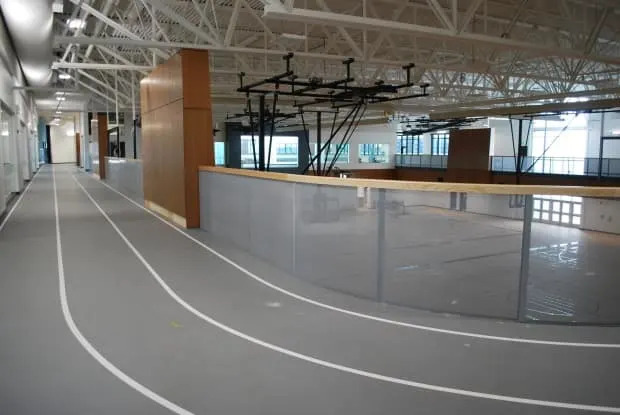Alberta no longer using P3 approach as preferred way to build schools
Mon, December 26, 2022

Infrastructure Minister Nathan Neudorf says the province is taking a step back from aggressively pursuing public-private partnership arrangements when building and replacing Alberta schools. (Nathan Neudorf/Facebook - image credit)
A 2019 UCP government promise to be aggressive in pursuing public-private partnerships (P3s) for building public facilities has fizzled in the education sector, with just five of 48 projects having used the model so far.
Infrastructure Minister Nathan Neudorf says P3s will no longer be the preferred method for major construction projects on Alberta schools. The model sees government agencies and private-sector companies collaborate on major infrastructure projects.
"Money, though very important, is not the only consideration," Neudorf told CBC News in an interview earlier this month. "There are other considerations that we want to adopt into this process and give value to."
Neudorf, who was appointed infrastructure minister and deputy premier in October, said he has nixed a plan to build six new school construction projects as a P3 bundle.
Alberta school capital projects status 2019-22
Government bundles, then unbundles, school projects
P3s make economic sense when a project costs more than $100 million, Neudorf said.
Since building a school can cost anywhere from $10 million to $90 million, depending on the size and complexity, governments often enter into P3 contracts to build "bundles" of the buildings, which usually use similar designs and materials, to save money.
In late 2019, former infrastructure minister Prasad Panda announced the United Conservative Party government intended to build five schools as P3s, including public and Catholic K-9 schools in Edmonton's Keswick area, an early elementary years school in Calgary, a francophone school in Legal and a Catholic K-9 school in Cochrane. Panda said, if they found it would be good value for money, even more of the 24 school projects promised in the 2019 budget could be P3s.
The news came after former premier Jason Kenney said the province would be "very aggressive" in pursuing the P3 approach to building public infrastructure.
The COVID-19 pandemic prompted the government to back away from its first P3 school bundle plan in 2020. Construction projects were financed and managed by the province.
That same year, Panda said five new high schools, including two in Edmonton, would be built using the P3 model. These buildings are now under construction and expected to be complete by 2024.
Of the 10 new school construction projects the province agreed to fund in 2022, Neudorf said the government had planned to bundle six together as a P3.
P3 schools in Alberta under construction
Neudorf, a carpenter who worked for years in commercial construction, said it would be challenging to find contractors who worked as far north as Valleyview and far south as Raymond, which would limit the competition, and potentially elevate the price of any bids.
Communities are also asking to build schools in combination with municipal amenities, such as recreation centres, theatres and libraries, Neudorf said.
Those types of joint projects don't work well for P3s, which usually use a common design between schools.
Edmonton public school board chair Trisha Estabrooks says schools need more flexibility to modify their spaces than most P3 arrangements allow.
"We need to be responsive to the needs of the students we have in our schools," she said in an interview last week.
She points to Dr. Anne Anderson High School, which opened in southwest Edmonton in 2021, and includes a community recreation centre. That kind of partnership wouldn't have been possible if the school was a P3, Estabrooks said.

Submitted by Edmonton Public Schools
Sometimes, a private company's control over the buildings is so restrictive, children have sweated in classrooms while Edmonton school staff had no control over the thermostat.
Some of the 40 P3 schools built by the former Progressive Conservative government were left with muddy fields fenced off and inaccessible for years while school boards were powerless to fix the problem. The private maintenance contracts can be as long as 30 years.
And while some governments sell P3 arrangements as a bargain for taxpayers, not all of the deals lead to long-term cost savings.
Highways, bridges, and hospitals could still be P3s, minister says
Estabrooks was at an Alberta School Boards' Association meeting last month, where Education Minister Adriana LaGrange told hundreds of trustees that P3 projects would no longer be the province's preferred method to build schools.
"She received overwhelming applause," Estabrooks said.
Urban trustees, especially, have raised concerns about P3 projects for years, she said.
In an email, Edmonton Catholic Schools spokesperson Christine Meadows said division leaders were pleased to learn a new Catholic K-9 school in west Edmonton and high school in Castle Downs will not be P3 builds.
"Our Division is not looking for changes to the P3 model, but rather to move away from it entirely," Meadows wrote.
Edmonton Catholic wants to have the freedom to manage all of its own school construction projects rather than rely on the province, she said.
NDP infrastructure critic Rod Loyola said, should his party form government after the 2023 provincial election, it would avoid P3 school builds.
"Even contemplating P3s has just led to loss of time," he said.
Loyola said the UCP government isn't building schools quickly enough for growing suburban neighbourhoods — a concern Estabrooks echoed.
The NDP committed in September to funding a $78-million Grade 7-12 school in Glenridding, and a public K-9 school in Edgemont, both in southwest Edmonton, where classroom space is sparse.
Although the P3 model may be out of vogue for schools for now, Neudorf doesn't rule out using the arrangements for building and financing other major public projects, such as hospitals, highways, overpasses and bridges.
His press secretary said in an email there hasn't been a deviation from the 2019 philosophy, saying each project is reviewed for the best value for Albertans.
Loyola didn't rule out a potential NDP government using the method for other builds, either.




